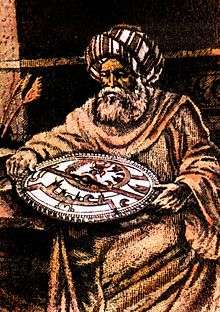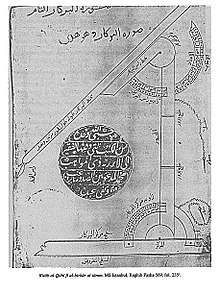Al-Battani
| Al-Battānī | |
|---|---|
 A modern artist's impression of al-Battānī holding an astrolabe | |
| Born |
c. 858 CE Harran, Bilad al-Sham |
| Died |
929 CE Qasr al-Jiss, near Samarra |
| Residence | Abbasid Caliphate |
| Academic background | |
| Influences | Ptolemy |
| Academic work | |
| Era | Islamic Golden Age |
| Main interests | Mathematics, Astronomy, Astrology |
| Notable works | Kitāb az-Zīj |
| Notable ideas |
|
| Influenced | Abū al-Wafā', al-Bīrūnī, Copernicus |
Abū ʿAbd Allāh Muḥammad ibn Jābir ibn Sinān al-Raqqī al-Ḥarrānī aṣ-Ṣābiʾ al-Battānī (Arabic: محمد بن جابر بن سنان البتاني) (Latinized as Albategnius, Albategni or Albatenius) (c. 858 – 929) was an Arab[1][2][3] astronomer, astrologer, and mathematician. He introduced a number of trigonometric relations, and his Kitāb az-Zīj was frequently quoted by many medieval astronomers, including Copernicus.[4]
Al-Battani is widely considered as the greatest and best known astronomer of the medieval Islamic world.[5][6][7][8]
Life
Little is known about al-Battānī's life beside that he was born in Harran near Urfa, in Upper Mesopotamia, which is now in Turkey, and his father was a famous maker of scientific instruments.[4] His epithet aṣ-Ṣabi’ suggests that among his ancestry were members of the Sabian sect; however, his full name indicates that he was Muslim.[9] Some western historians state that he is of noble origin, like an Arab prince,[10] but traditional Arabic biographers make no mention of this.[4] He lived and worked in Raqqa, a city in north central Syria.
Astronomy
One of al-Battānī's best-known achievements in astronomy was the determination of the solar year as being 365 days, 5 hours, 46 minutes and 24 seconds which is only 2 minutes and 22 seconds off.[9]
He was able to correct some of Ptolemy's results and compiled new tables of the Sun and Moon, long accepted as authoritative.[10] Some of his measurements were even more accurate than ones taken by Copernicus many centuries later. Researchers have ascribed this phenomenon to al-Battānī's location lying closer to the equator so that the ecliptic and the Sun were higher in the sky and therefore less susceptible to atmospheric refraction.[9]
Al-Battānī discovered that the direction of the Sun's apogee, as recorded by Ptolemy, was changing.[11] (In modern heliocentric terms this is due to the changing direction of the eccentricity vector of the Earth's orbit). He also introduced, probably independently of the 5th century Indian astronomer Aryabhata, the use of sines in calculation, and partially that of tangents.[10] He also calculated the values for the precession of the equinoxes (54.5" per year, or 1° in 66 years) and the obliquity of the ecliptic (23° 35').[9] He used a uniform rate for precession in his tables, choosing not to adopt the theory of trepidation attributed to his colleague Thabit ibn Qurra.
Al-Battānī's work is considered instrumental in the development of science and astronomy.[9] Copernicus quoted him in the book that initiated the Copernican Revolution, the De Revolutionibus Orbium Coelestium, where his name is mentioned no fewer than 23 times,[12] and also mentioned him in the Commentariolus.[13] Al-Battānī was frequently quoted by Tycho Brahe and Riccioli, among others. Kepler and Galileo showed interest in some of his observations,[4] and his data continues to be used in geophysics.[14]
Mathematics
In mathematics, al-Battānī produced a number of trigonometrical relationships:
He also solved the equation sin x = a cos x discovering the formula:
He gives other trigonometric formulae for right-angled triangles such as:[9]
Al-Battānī used al-Marwazi's idea of tangents ("shadows") to develop equations for calculating tangents and cotangents, compiling tables of them. He also discovered the reciprocal functions of secant and cosecant, and produced the first table of cosecants, which he referred to as a "table of shadows" (in reference to the shadow of a gnomon), for each degree from 1° to 90°.[15]
Works
Al-Battānī's major work is Kitāb az-Zīj ("Book of Astronomical Tables"). It was largely based on Ptolemy's theory, and other Greco-Syriac sources, while showing little Indian or Persian influence.[4][16] In his zij, he provided descriptions of a quadrant instrument.[17]
This book went through many translations to Latin and Spanish, including a Latin translation as De Motu Stellarum by Plato of Tivoli in 1116, which was later reprinted with annotations by Regiomontanus.[10] A reprint appeared at Bologna in 1645. The original MS. is preserved at the Vatican; and the Escorial library possesses in MS. a treatise of some value by him on astronomical chronology.[10]
See also
Notes
- ↑ C.A., Nallino,. "al-BATTĀNĪ". Encyclopaedia of Islam, Second Edition. Brill. doi:10.1163/1573-3912_islam_sim_1289. Retrieved 26 March 2017.
- ↑ "Al-Battānī | Arab astronomer and mathematician". Encyclopedia Britannica.
- ↑ "Al-Battani - Oxford Reference". doi:10.1093/oi/authority.20110803095359912.
- 1 2 3 4 5 Hartner, Willy (1970–80). "Al-Battānī, Abū ʿAbd Allāh Muḥammad Ibn Jābir Ibn Sinān al-Raqqī al-Ḥarrānī al–Ṣābi". Dictionary of Scientific Biography. New York: Charles Scribner's Sons. ISBN 0-684-10114-9.
- ↑ Schlager, Neil; Lauer, Josh (2001). Science and Its Times: 700-1449. Gale Group. p. 291.
- ↑ Griffin, Rosarii (2006). Education in the Muslim World: different perspectives. Symposium Books Ltd. p. 31.
- ↑ Angelo, Joseph A. (2014). Encyclopedia of Space and Astronomy. Infobase Publishing. p. 78.
- ↑ Ben-Menaḥem, Ari (2009). Historical Encyclopedia of Natural and Mathematical Sciences. Springer Science & Business Media. p. 541.
- 1 2 3 4 5 6 O'Connor, John J.; Robertson, Edmund F., "Al-Battani", MacTutor History of Mathematics archive, University of St Andrews .
- 1 2 3 4 5

- ↑ Singer, Charles Joseph (1997). A short history of science to the nineteenth century. Courier Dover Publications. p. 135. ISBN 978-0-486-29887-0.
- ↑ Hoskin, Michael (1999-03-18). The Cambridge Concise History of Astronomy. Cambridge University Press. p. 58. ISBN 9780521576000.
- ↑ Freely, John (2015-03-30). Light from the East: How the Science of Medieval Islam Helped to Shape the Western World. I.B.Tauris. p. 179. ISBN 9781784531386.
- ↑ Dalmau, W. (1997) CRITICAL REMARKS ON THE USE OF MEDIEVAL ECLIPSE RECORDS FOR THE DETERMINATION OF LONG-TERM CHANGES IN THE EARTH'S ROTATION', Surveys in Geophysics 18: 213-223.
- ↑ "trigonometry". Encyclopædia Britannica. Retrieved 2008-07-21.
- ↑ E. S. Kennedy, A Survey of Islamic Astronomical Tables, (Transactions of the American Philosophical Society, New Series, 46, 2), Philadelphia, 1956, pp. 10–11, 32–34.
- ↑ Moussa, Ali (2011). "Mathematical Methods in Abū al-Wafāʾ's Almagest and the Qibla Determinations". Arabic Sciences and Philosophy. Cambridge University Press. 21 (1). doi:10.1017/S095742391000007X.
References
- Al-Battānī sive Albatenii, Opus Astronomicum. Ad fidem codicis escurialensis arabice editum, ed. by Carlo Alfonso Nallino. Milan, Ulrico Hoepli, 1899-1907 [= Pubblicazioni del Reale Osservatorio di Brera in Milano, nr. XL], 412 + 450 + 288 pp. (anast.: I-III, [La Finestra editrice], Lavis 2002 ISBN 978-8888097-26-8
- Hartner, Willy (1970–80). "Al-Battānī, Abū ʿAbd Allāh Muḥammad Ibn Jābir Ibn Sinān al-Raqqī al-Ḥarrānī al–Ṣābi". Dictionary of Scientific Biography. New York: Charles Scribner's Sons. ISBN 0-684-10114-9.
- O'Connor, John J.; Robertson, Edmund F., "Abu Abdallah Mohammad ibn Jabir Al-Battani", MacTutor History of Mathematics archive, University of St Andrews .
External links
- Dalen, Benno van (2007). "Battānī: Abū ʿAbd Allāh Muḥammad ibn Jābir ibn Sinān al‐Battānī al‐Ḥarrānī al‐Ṣābiʾ". In Thomas Hockey; et al. The Biographical Encyclopedia of Astronomers. New York: Springer. pp. 101–3. ISBN 978-0-387-31022-0. (PDF version)
- Weisstein, Eric Wolfgang (ed.). "Albategnius (ca. 858–929)". ScienceWorld.

- Gilman, D. C.; Peck, H. T.; Colby, F. M., eds. (1905). "al-Battani, Mohammed ibn Jabir ibn Sinan". New International Encyclopedia (1st ed.). New York: Dodd, Mead.
- "Albategnius". Encyclopædia Britannica. 1 (11th ed.). 1911. p. 491.
- "al-Battani". New International Encyclopedia. 1920.
